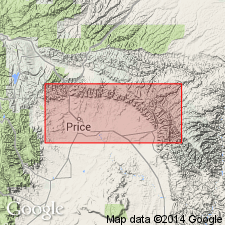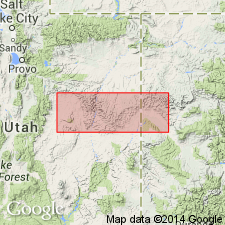
- Usage in publication:
-
- Spring Canyon tongue*
- Modifications:
-
- Named
- Dominant lithology:
-
- Sandstone
- AAPG geologic province:
-
- Uinta basin
Summary:
The name Spring Canyon tongue is proposed for the upper tongue of Star Point Sandstone of Mesaverde group. Consists of grayish sandstone about 150 feet thick with a conspicuous white layer at top. To the east it is split by interfingering tongues of Mancos shale. A basal thin bed (50 feet thick) of limy concretions, sandstone, and sandy shale increases in thickness to the west. Middle and upper parts also increase in thickness to the west. Is usually overlain by Spring Canyon coal group of the overlying Blackhawk formation, or, where the coal is absent, by Aberdeen sandstone member (new) of Blackhawk. Is separated from the older Storrs tongue (new) of Star Point by Mancos shale. Merges with the older Storrs tongue to the west, to form the upper part of Star Point. Age is Late Cretaceous. Report includes geologic map, cross section.
Type locality not designated. Named from Spring Canyon in Book Cliffs, northern part of Castlegate quadrangle, Carbon Co., UT (Uinta basin).
Source: Modified from GNU records (USGS DDS-6; Menlo GNULEX).

- Usage in publication:
-
- Spring Canyon member
- Modifications:
-
- Revised
- Redescribed
- Areal extent
- Dominant lithology:
-
- Sandstone
- Shale
- Coal
- AAPG geologic province:
-
- Uinta basin
Summary:
Is a Uinta basin unit that is reassigned from the Star Point sandstone as its upper member to the Blackhawk formation as its lower member. Revised to include sandstone of the Spring Canyon tongue as well as the overlying Spring Canyon coal group of Clark (1928). The change of contact modifies its original lithologic description in that the member consists of a massive basal sandstone 100 ft thick (Clark's Spring Canyon tongue) and an overlying coal-bearing shale and sandstone (Clark's Spring Canyon coal group) of fresh- and brackish-water origin 60-100 ft thick. The coal-bearing rocks were deposited behind offshore bar sandstones. The sandstones thin eastward and disappear into the Mancos shale. Three important coal beds present. Hiawatha coal is the thickest. Spring Canyon is underlain by, intertongued with, and overlain by Mancos. Tongues out between Dugout Creek and Page Canyon, about 12 mi northwest of Sunnyside, Carbon Co, UT. Cross sections. Late Cretaceous age.
Source: GNU records (USGS DDS-6; Denver GNULEX).
For more information, please contact Nancy Stamm, Geologic Names Committee Secretary.
Asterisk (*) indicates published by U.S. Geological Survey authors.
"No current usage" (†) implies that a name has been abandoned or has fallen into disuse. Former usage and, if known, replacement name given in parentheses ( ).
Slash (/) indicates name conflicts with nomenclatural guidelines (CSN, 1933; ACSN, 1961, 1970; NACSN, 1983, 2005, 2021). May be explained within brackets ([ ]).

